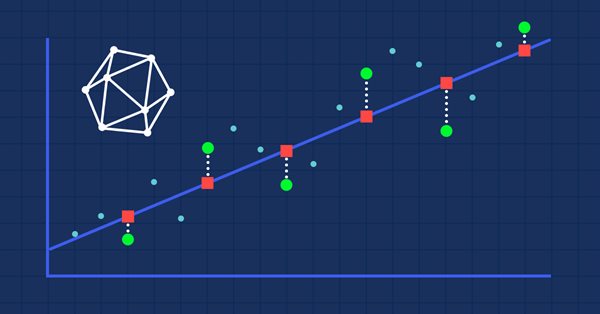
利用回归衡量度评估 ONNX 模型
概述
回归是一项依据未标记样本预测真实数值的任务。 一个著名的回归例子是基于大小、重量、颜色、净度、等特征来估算钻石的价值。
而所谓的回归衡量度则是用来评估回归模型的预测准确性。 尽管算法相似,回归衡量度在语义上与相似的损失函数有所区别。 了解它们之间的区别很重要。 它可按如下方式表述:
-
当我们将构建模型的问题降解为优化问题时,此刻损失函数就会浮现。 通常要求它具有良好的性质(例如,可微性)
-
衡量度是外部客观品质准则,通常不依赖于模型参数,而仅建立在预测值之上。
MQL5 中的回归衡量度
MQL5 语言具有以下衡量度:
- 平均绝对误差,MAE
- 均方误差,MSE
- 均方根误差,RMSE
- R-平方,R2
- 平均绝对百分比误差,MAPE
- 均方百分比误差,MSPE
- 均方根对数误差,RMSLE
预计 MQL5 中回归衡量度的数量还会增加。
回归衡量度的简明特征
MAE 估算绝对误差 — 预测数字偏离实际数字的程度。 误差的测量单位与目标函数的数值相同。 错误值基于可能的数值范围进行解释。 例如,如果目标值在 1 到 1.5 的范围内,则平均绝对误差值为 10 就是一个非常大的误差;而对于 10000...15000 的范围,那就可以接受。 它不适合针对扩散较大的数值评估预测。
在 MSE 中,由于平方,每个误差都有自己的权重。 由此,预测与现实之间的巨大差异更加明显。
RMSE 具有与 MSE 相同的优点,但更易于理解,因为误差的测量单位与目标函数的数值相同。 它对异常和尖峰非常敏感。 MAE 和 RMSE 可以一起使用,来检测一组预测中的误差变化。 RMSE 始终大于或等于 MAE。 它们之间的差值越大,样本中独立误差的扩散就越大。 如果 RMSE = MAE,则所有误差的幅度相同。
R2 — 判定率表示两个随机变量之间的关系强度。 它有助于判定模型能够解释的数据多样性的份额。 如果模型始终准确预测,则衡量度为 1。 对于泛泛的模型,它是 0。 如果模型预测比泛泛者还糟糕,同时模型不遵循数据趋势,则衡量度数值可能为负值。
MAPE — 误差没有量纲,非常容易解释。 它既可以表示为小数,也可以表示为百分比。 在 MQL5 中,它以小数表达。 例如,值 0.1 表示误差为真实数值的 10%。 该衡量度背后的思想是对于相对偏差的敏感性。 它不适用于需要使用真实测量单位的任务。
MSPE 可被认为是 MSE 的加权版本,其中权重与观测值的平方成反比。 因此,随着观测值的递增,误差趋于递减。
RMSLE 用于实际值超出若干个数量级时。 根据定义,预测值和实际观测值不能为负值。
计算上述所有衡量度的算法在源文件 VectorRegressionMetric.mqh 中提供。
ONNX 模型
我们用到 4 个回归模型,依据日线的前一根柱线预测当天的收盘价(EURUSD, D1)。 我们在之前的文章中研究了这些模型:“在类中包装 ONNX 模型”、“如何在 MQL5 中集成 ONNX 模型的示例”,以及 “如何在 MQL5 中使用 ONNX 模型”。 故此,我们不会在此重复训练模型所用的规则。 训练所有模型的脚本位于本文随附的 zip 存档的 Python 子文件夹之中。 经训练的 onnx 模型 — model.eurusd.D1.10、model.eurusd.D1.30、model.eurusd.D1.52 和 model.eurusd.D1.63 也位于那里。
在类中包装 ONNX 模型
在上一篇文章中,我们展示了 ONNX 模型的基类和分类模型的派生类。 我们已针对基类进行了一些小的修改,令其更加灵活。
//+------------------------------------------------------------------+ //| ModelSymbolPeriod.mqh | //| Copyright 2023, MetaQuotes Ltd. | //| https://www.mql5.com | //+------------------------------------------------------------------+ //--- price movement prediction #define PRICE_UP 0 #define PRICE_SAME 1 #define PRICE_DOWN 2 //+------------------------------------------------------------------+ //| Base class for models based on trained symbol and period | //+------------------------------------------------------------------+ class CModelSymbolPeriod { protected: string m_name; // model name long m_handle; // created model session handle string m_symbol; // symbol of trained data ENUM_TIMEFRAMES m_period; // timeframe of trained data datetime m_next_bar; // time of next bar (we work at bar begin only) double m_class_delta; // delta to recognize "price the same" in regression models public: //+------------------------------------------------------------------+ //| Constructor | //+------------------------------------------------------------------+ CModelSymbolPeriod(const string symbol,const ENUM_TIMEFRAMES period,const double class_delta=0.0001) { m_name=""; m_handle=INVALID_HANDLE; m_symbol=symbol; m_period=period; m_next_bar=0; m_class_delta=class_delta; } //+------------------------------------------------------------------+ //| Destructor | //+------------------------------------------------------------------+ ~CModelSymbolPeriod(void) { Shutdown(); } //+------------------------------------------------------------------+ //| | //+------------------------------------------------------------------+ string GetModelName(void) { return(m_name); } //+------------------------------------------------------------------+ //| virtual stub for Init | //+------------------------------------------------------------------+ virtual bool Init(const string symbol, const ENUM_TIMEFRAMES period) { return(false); } //+------------------------------------------------------------------+ //| Check for initialization, create model | //+------------------------------------------------------------------+ bool CheckInit(const string symbol, const ENUM_TIMEFRAMES period,const uchar& model[]) { //--- check symbol, period if(symbol!=m_symbol || period!=m_period) { PrintFormat("Model must work with %s,%s",m_symbol,EnumToString(m_period)); return(false); } //--- create a model from static buffer m_handle=OnnxCreateFromBuffer(model,ONNX_DEFAULT); if(m_handle==INVALID_HANDLE) { Print("OnnxCreateFromBuffer error ",GetLastError()); return(false); } //--- ok return(true); } //+------------------------------------------------------------------+ //| Release ONNX session | //+------------------------------------------------------------------+ void Shutdown(void) { if(m_handle!=INVALID_HANDLE) { OnnxRelease(m_handle); m_handle=INVALID_HANDLE; } } //+------------------------------------------------------------------+ //| Check for continue OnTick | //+------------------------------------------------------------------+ virtual bool CheckOnTick(void) { //--- check new bar if(TimeCurrent()<m_next_bar) return(false); //--- set next bar time m_next_bar=TimeCurrent(); m_next_bar-=m_next_bar%PeriodSeconds(m_period); m_next_bar+=PeriodSeconds(m_period); //--- work on new day bar return(true); } //+------------------------------------------------------------------+ //| virtual stub for PredictPrice (regression model) | //+------------------------------------------------------------------+ virtual double PredictPrice(datetime date) { return(DBL_MAX); } //+------------------------------------------------------------------+ //| Predict class (regression ~> classification) | //+------------------------------------------------------------------+ virtual int PredictClass(datetime date,vector& probabilities) { date-=date%PeriodSeconds(m_period); double predicted_price=PredictPrice(date); if(predicted_price==DBL_MAX) return(-1); double last_close[2]; if(CopyClose(m_symbol,m_period,date,2,last_close)!=2) return(-1); double prev_price=last_close[0]; //--- classify predicted price movement int predicted_class=-1; double delta=prev_price-predicted_price; if(fabs(delta)<=m_class_delta) predicted_class=PRICE_SAME; else { if(delta<0) predicted_class=PRICE_UP; else predicted_class=PRICE_DOWN; } //--- set predicted probability as 1.0 probabilities.Fill(0); if(predicted_class<(int)probabilities.Size()) probabilities[predicted_class]=1; //--- and return predicted class return(predicted_class); } }; //+------------------------------------------------------------------+
我们已在 PredictPrice 和 PredictClass 方法中加入了一个 datetime 参数,以便我们可以在任何时间点进行预测,而不仅只在当下。 这对于形成预测向量很实用。
D1_10 模型类
我们的第一个模型称为 model.eurusd.D1.10.onnx。 回归模型依据 EURUSD D1 的 10 个 OHLC 价格序列进行了训练。//+------------------------------------------------------------------+ //| ModelEurusdD1_10.mqh | //| Copyright 2023, MetaQuotes Ltd. | //| https://www.mql5.com | //+------------------------------------------------------------------+ #include "ModelSymbolPeriod.mqh" #resource "Python/model.eurusd.D1.10.onnx" as uchar model_eurusd_D1_10[] //+------------------------------------------------------------------+ //| ONNX-model wrapper class | //+------------------------------------------------------------------+ class CModelEurusdD1_10 : public CModelSymbolPeriod { private: int m_sample_size; public: //+------------------------------------------------------------------+ //| Constructor | //+------------------------------------------------------------------+ CModelEurusdD1_10(void) : CModelSymbolPeriod("EURUSD",PERIOD_D1) { m_name="D1_10"; m_sample_size=10; } //+------------------------------------------------------------------+ //| ONNX-model initialization | //+------------------------------------------------------------------+ virtual bool Init(const string symbol, const ENUM_TIMEFRAMES period) { //--- check symbol, period, create model if(!CModelSymbolPeriod::CheckInit(symbol,period,model_eurusd_D1_10)) { Print("model_eurusd_D1_10 : initialization error"); return(false); } //--- since not all sizes defined in the input tensor we must set them explicitly //--- first index - batch size, second index - series size, third index - number of series (OHLC) const long input_shape[] = {1,m_sample_size,4}; if(!OnnxSetInputShape(m_handle,0,input_shape)) { Print("model_eurusd_D1_10 : OnnxSetInputShape error ",GetLastError()); return(false); } //--- since not all sizes defined in the output tensor we must set them explicitly //--- first index - batch size, must match the batch size of the input tensor //--- second index - number of predicted prices const long output_shape[] = {1,1}; if(!OnnxSetOutputShape(m_handle,0,output_shape)) { Print("model_eurusd_D1_10 : OnnxSetOutputShape error ",GetLastError()); return(false); } //--- ok return(true); } //+------------------------------------------------------------------+ //| Predict price | //+------------------------------------------------------------------+ virtual double PredictPrice(datetime date) { static matrixf input_data(m_sample_size,4); // matrix for prepared input data static vectorf output_data(1); // vector to get result static matrix mm(m_sample_size,4); // matrix of horizontal vectors Mean static matrix ms(m_sample_size,4); // matrix of horizontal vectors Std static matrix x_norm(m_sample_size,4); // matrix for prices normalize //--- prepare input data matrix rates; //--- request last bars date-=date%PeriodSeconds(m_period); if(!rates.CopyRates(m_symbol,m_period,COPY_RATES_OHLC,date-1,m_sample_size)) return(DBL_MAX); //--- get series Mean vector m=rates.Mean(1); //--- get series Std vector s=rates.Std(1); //--- prepare matrices for prices normalization for(int i=0; i<m_sample_size; i++) { mm.Row(m,i); ms.Row(s,i); } //--- the input of the model must be a set of vertical OHLC vectors x_norm=rates.Transpose(); //--- normalize prices x_norm-=mm; x_norm/=ms; //--- run the inference input_data.Assign(x_norm); if(!OnnxRun(m_handle,ONNX_NO_CONVERSION,input_data,output_data)) return(DBL_MAX); //--- denormalize the price from the output value double predicted=output_data[0]*s[3]+m[3]; //--- return prediction return(predicted); } }; //+------------------------------------------------------------------+
这个模型类似于我们在公开项目 MQL5\Shared Projects\ONNX.Price.Prediction 中发布的第一个模型。
10 个 OHLC 价格序列应按照与训练期间相同的方式进行常规化,即序列中与平均价格的偏差除以序列中的标准差。 如此,我们将序列纳于一定范围之内,均值为 0,扩散为 1,这样就提高了训练期间的收敛性。
D1_30 模型类
第二个模型称为 model.eurusd.D1.30.onnx。 回归模型的训练依据 EURUSD D1 的 30 个收盘价序列,和两条均化周期分别为 21 和 34 的简单移动平均线。
//+------------------------------------------------------------------+ //| ModelEurusdD1_30.mqh | //| Copyright 2023, MetaQuotes Ltd. | //| https://www.mql5.com | //+------------------------------------------------------------------+ #include "ModelSymbolPeriod.mqh" #resource "Python/model.eurusd.D1.30.onnx" as uchar model_eurusd_D1_30[] //+------------------------------------------------------------------+ //| ONNX-model wrapper class | //+------------------------------------------------------------------+ class CModelEurusdD1_30 : public CModelSymbolPeriod { private: int m_sample_size; int m_fast_period; int m_slow_period; int m_sma_fast; int m_sma_slow; public: //+------------------------------------------------------------------+ //| Constructor | //+------------------------------------------------------------------+ CModelEurusdD1_30(void) : CModelSymbolPeriod("EURUSD",PERIOD_D1) { m_name="D1_30"; m_sample_size=30; m_fast_period=21; m_slow_period=34; m_sma_fast=INVALID_HANDLE; m_sma_slow=INVALID_HANDLE; } //+------------------------------------------------------------------+ //| ONNX-model initialization | //+------------------------------------------------------------------+ virtual bool Init(const string symbol, const ENUM_TIMEFRAMES period) { //--- check symbol, period, create model if(!CModelSymbolPeriod::CheckInit(symbol,period,model_eurusd_D1_30)) { Print("model_eurusd_D1_30 : initialization error"); return(false); } //--- since not all sizes defined in the input tensor we must set them explicitly //--- first index - batch size, second index - series size, third index - number of series (Close, MA fast, MA slow) const long input_shape[] = {1,m_sample_size,3}; if(!OnnxSetInputShape(m_handle,0,input_shape)) { Print("model_eurusd_D1_30 : OnnxSetInputShape error ",GetLastError()); return(false); } //--- since not all sizes defined in the output tensor we must set them explicitly //--- first index - batch size, must match the batch size of the input tensor //--- second index - number of predicted prices const long output_shape[] = {1,1}; if(!OnnxSetOutputShape(m_handle,0,output_shape)) { Print("model_eurusd_D1_30 : OnnxSetOutputShape error ",GetLastError()); return(false); } //--- indicators m_sma_fast=iMA(m_symbol,m_period,m_fast_period,0,MODE_SMA,PRICE_CLOSE); m_sma_slow=iMA(m_symbol,m_period,m_slow_period,0,MODE_SMA,PRICE_CLOSE); if(m_sma_fast==INVALID_HANDLE || m_sma_slow==INVALID_HANDLE) { Print("model_eurusd_D1_30 : cannot create indicator"); return(false); } //--- ok return(true); } //+------------------------------------------------------------------+ //| Predict price | //+------------------------------------------------------------------+ virtual double PredictPrice(datetime date) { static matrixf input_data(m_sample_size,3); // matrix for prepared input data static vectorf output_data(1); // vector to get result static matrix x_norm(m_sample_size,3); // matrix for prices normalize static vector vtemp(m_sample_size); static double ma_buffer[]; //--- request last bars date-=date%PeriodSeconds(m_period); if(!vtemp.CopyRates(m_symbol,m_period,COPY_RATES_CLOSE,date-1,m_sample_size)) return(DBL_MAX); //--- get series Mean double m=vtemp.Mean(); //--- get series Std double s=vtemp.Std(); //--- normalize vtemp-=m; vtemp/=s; x_norm.Col(vtemp,0); //--- fast sma if(CopyBuffer(m_sma_fast,0,date-1,m_sample_size,ma_buffer)!=m_sample_size) return(-1); vtemp.Assign(ma_buffer); m=vtemp.Mean(); s=vtemp.Std(); vtemp-=m; vtemp/=s; x_norm.Col(vtemp,1); //--- slow sma if(CopyBuffer(m_sma_slow,0,date-1,m_sample_size,ma_buffer)!=m_sample_size) return(-1); vtemp.Assign(ma_buffer); m=vtemp.Mean(); s=vtemp.Std(); vtemp-=m; vtemp/=s; x_norm.Col(vtemp,2); //--- run the inference input_data.Assign(x_norm); if(!OnnxRun(m_handle,ONNX_NO_CONVERSION,input_data,output_data)) return(DBL_MAX); //--- denormalize the price from the output value double predicted=output_data[0]*s+m; //--- return prediction return(predicted); } }; //+------------------------------------------------------------------+
与之前的类一样,在 Init 方法中调用 CheckInit 基类方法。 在基类方法中,为 ONNX 模型创建一个时段,并显式设置输入和输出张量的大小。
PredictPrice 方法提供 30 个之前的收盘价序列,以及计算出的移动平均线。 数据的常规化方式与训练相同。
该模型是为 “在类中包装 ONNX 模型” 一文开发的,并为本文目的将其从分类转换到回归。
D1_52 模型类
第三个模型称为 model.eurusd.D1.52.onnx。 回归模型的训练依据 EURUSD D1 的 52 个收盘价序列。
//+------------------------------------------------------------------+ //| ModelEurusdD1_52.mqh | //| Copyright 2023, MetaQuotes Ltd. | //| https://www.mql5.com | //+------------------------------------------------------------------+ #include "ModelSymbolPeriod.mqh" #resource "Python/model.eurusd.D1.52.onnx" as uchar model_eurusd_D1_52[] //+------------------------------------------------------------------+ //| ONNX-model wrapper class | //+------------------------------------------------------------------+ class CModelEurusdD1_52 : public CModelSymbolPeriod { private: int m_sample_size; public: //+------------------------------------------------------------------+ //| Constructor | //+------------------------------------------------------------------+ CModelEurusdD1_52(void) : CModelSymbolPeriod("EURUSD",PERIOD_D1,0.0001) { m_name="D1_52"; m_sample_size=52; } //+------------------------------------------------------------------+ //| ONNX-model initialization | //+------------------------------------------------------------------+ virtual bool Init(const string symbol, const ENUM_TIMEFRAMES period) { //--- check symbol, period, create model if(!CModelSymbolPeriod::CheckInit(symbol,period,model_eurusd_D1_52)) { Print("model_eurusd_D1_52 : initialization error"); return(false); } //--- since not all sizes defined in the input tensor we must set them explicitly //--- first index - batch size, second index - series size, third index - number of series (only Close) const long input_shape[] = {1,m_sample_size,1}; if(!OnnxSetInputShape(m_handle,0,input_shape)) { Print("model_eurusd_D1_52 : OnnxSetInputShape error ",GetLastError()); return(false); } //--- since not all sizes defined in the output tensor we must set them explicitly //--- first index - batch size, must match the batch size of the input tensor //--- second index - number of predicted prices (we only predict Close) const long output_shape[] = {1,1}; if(!OnnxSetOutputShape(m_handle,0,output_shape)) { Print("model_eurusd_D1_52 : OnnxSetOutputShape error ",GetLastError()); return(false); } //--- ok return(true); } //+------------------------------------------------------------------+ //| Predict price | //+------------------------------------------------------------------+ virtual double PredictPrice(datetime date) { static vectorf output_data(1); // vector to get result static vector x_norm(m_sample_size); // vector for prices normalize //--- set date to day begin date-=date%PeriodSeconds(m_period); //--- check for calculate min and max double price_min=0; double price_max=0; GetMinMaxClose(date,price_min,price_max); //--- check for normalization possibility if(price_min>=price_max) return(DBL_MAX); //--- request last bars if(!x_norm.CopyRates(m_symbol,m_period,COPY_RATES_CLOSE,date-1,m_sample_size)) return(DBL_MAX); //--- normalize prices x_norm-=price_min; x_norm/=(price_max-price_min); //--- run the inference if(!OnnxRun(m_handle,ONNX_DEFAULT,x_norm,output_data)) return(DBL_MAX); //--- denormalize the price from the output value double predicted=output_data[0]*(price_max-price_min)+price_min; //--- return prediction return(predicted); } private: //+------------------------------------------------------------------+ //| Get minimal and maximal Close for last 52 weeks | //+------------------------------------------------------------------+ void GetMinMaxClose(const datetime date,double& price_min,double& price_max) { static vector close; close.CopyRates(m_symbol,m_period,COPY_RATES_CLOSE,date,m_sample_size*7+1); price_min=close.Min(); price_max=close.Max(); } }; //+------------------------------------------------------------------+
提交模型之前的价格常规化与以前的不同。 在训练期间用到了 MinMaxScaler。 因此,我们取预测日期之前 52 周的最低价和最高价。
该模型类似于 “如何在 MQL5 中使用 ONNX 模型” 一文中所述的模型。
D1_63 模型类
最后,第四个模型称为 model.eurusd.D1.63.onnx。 回归模型的训练依据 EURUSD D1 的 63 个收盘价序列。
//+------------------------------------------------------------------+ //| ModelEurusdD1_63.mqh | //| Copyright 2023, MetaQuotes Ltd. | //| https://www.mql5.com | //+------------------------------------------------------------------+ #include "ModelSymbolPeriod.mqh" #resource "Python/model.eurusd.D1.63.onnx" as uchar model_eurusd_D1_63[] //+------------------------------------------------------------------+ //| ONNX-model wrapper class | //+------------------------------------------------------------------+ class CModelEurusdD1_63 : public CModelSymbolPeriod { private: int m_sample_size; public: //+------------------------------------------------------------------+ //| Constructor | //+------------------------------------------------------------------+ CModelEurusdD1_63(void) : CModelSymbolPeriod("EURUSD",PERIOD_D1) { m_name="D1_63"; m_sample_size=63; } //+------------------------------------------------------------------+ //| ONNX-model initialization | //+------------------------------------------------------------------+ virtual bool Init(const string symbol, const ENUM_TIMEFRAMES period) { //--- check symbol, period, create model if(!CModelSymbolPeriod::CheckInit(symbol,period,model_eurusd_D1_63)) { Print("model_eurusd_D1_63 : initialization error"); return(false); } //--- since not all sizes defined in the input tensor we must set them explicitly //--- first index - batch size, second index - series size const long input_shape[] = {1,m_sample_size}; if(!OnnxSetInputShape(m_handle,0,input_shape)) { Print("model_eurusd_D1_63 : OnnxSetInputShape error ",GetLastError()); return(false); } //--- since not all sizes defined in the output tensor we must set them explicitly //--- first index - batch size, must match the batch size of the input tensor //--- second index - number of predicted prices const long output_shape[] = {1,1}; if(!OnnxSetOutputShape(m_handle,0,output_shape)) { Print("model_eurusd_D1_63 : OnnxSetOutputShape error ",GetLastError()); return(false); } //--- ok return(true); } //+------------------------------------------------------------------+ //| Predict price | //+------------------------------------------------------------------+ virtual double PredictPrice(datetime date) { static vectorf input_data(m_sample_size); // vector for prepared input data static vectorf output_data(1); // vector to get result //--- request last bars date-=date%PeriodSeconds(m_period); if(!input_data.CopyRates(m_symbol,m_period,COPY_RATES_CLOSE,date-1,m_sample_size)) return(DBL_MAX); //--- get series Mean float m=input_data.Mean(); //--- get series Std float s=input_data.Std(); //--- normalize prices input_data-=m; input_data/=s; //--- run the inference if(!OnnxRun(m_handle,ONNX_NO_CONVERSION,input_data,output_data)) return(DBL_MAX); //--- denormalize the price from the output value double predicted=output_data[0]*s+m; //--- return prediction return(predicted); } }; //+------------------------------------------------------------------+
PredictPrice 方法提供以前的 63 个收盘价序列。 数据的常规化方式与第一个和第二个模型相同。
该模型是为文章 “如何在 MQL5 中集成 ONNX 模型的示例” 而开发。
将所有模型合并到一个脚本当中。 现实、预测和回归衡量度
为了应用回归衡量度,我们应该做出一定数量的预测(vector_pred),并取相同日期(vector_true)的真实数据。
由于我们在类中包装所有的模型,都派生自相同的基类,因此我们可以一次性评估它们。
脚本非常简单
//+------------------------------------------------------------------+ //| ONNX.eurusd.D1.4M.Metrics.mq5 | //| Copyright 2023, MetaQuotes Ltd. | //| https://www.mql5.com | //+------------------------------------------------------------------+ #property copyright "Copyright 2023, MetaQuotes Ltd." #property link "https://www.mql5.com" #property version "1.00" #define MODELS 4 #include "ModelEurusdD1_10.mqh" #include "ModelEurusdD1_30.mqh" #include "ModelEurusdD1_52.mqh" #include "ModelEurusdD1_63.mqh" #property script_show_inputs input datetime InpStartDate = D'2023.01.01'; input datetime InpStopDate = D'2023.01.31'; CModelSymbolPeriod *ExtModels[MODELS]; struct PredictedPrices { string model; double pred[]; }; PredictedPrices ExtPredicted[MODELS]; double ExtClose[]; struct Metrics { string model; double mae; double mse; double rmse; double r2; double mape; double mspe; double rmsle; }; Metrics ExtMetrics[MODELS]; //+------------------------------------------------------------------+ //| Script program start function | //+------------------------------------------------------------------+ void OnStart() { //--- init section if(!Init()) return; //--- predictions test loop datetime dates[]; if(CopyTime(_Symbol,_Period,InpStartDate,InpStopDate,dates)<=0) { Print("Cannot get data from ",InpStartDate," to ",InpStopDate); return; } for(uint n=0; n<dates.Size(); n++) GetPredictions(dates[n]); CopyClose(_Symbol,_Period,InpStartDate,InpStopDate,ExtClose); CalculateMetrics(); //--- deinit section Deinit(); } //+------------------------------------------------------------------+ //| | //+------------------------------------------------------------------+ bool Init() { ExtModels[0]=new CModelEurusdD1_10; ExtModels[1]=new CModelEurusdD1_30; ExtModels[2]=new CModelEurusdD1_52; ExtModels[3]=new CModelEurusdD1_63; for(long i=0; i<ExtModels.Size(); i++) { if(!ExtModels[i].Init(_Symbol,_Period)) { Deinit(); return(false); } } for(long i=0; i<ExtModels.Size(); i++) ExtPredicted[i].model=ExtModels[i].GetModelName(); return(true); } //+------------------------------------------------------------------+ //| | //+------------------------------------------------------------------+ void Deinit() { for(uint i=0; i<ExtModels.Size(); i++) delete ExtModels[i]; } //+------------------------------------------------------------------+ //| | //+------------------------------------------------------------------+ void GetPredictions(datetime date) { //--- collect predicted prices for(uint i=0; i<ExtModels.Size(); i++) ExtPredicted[i].pred.Push(ExtModels[i].PredictPrice(date)); } //+------------------------------------------------------------------+ //| | //+------------------------------------------------------------------+ void CalculateMetrics() { vector vector_pred,vector_true; vector_true.Assign(ExtClose); for(uint i=0; i<ExtModels.Size(); i++) { ExtMetrics[i].model=ExtPredicted[i].model; vector_pred.Assign(ExtPredicted[i].pred); ExtMetrics[i].mae =vector_pred.RegressionMetric(vector_true,REGRESSION_MAE); ExtMetrics[i].mse =vector_pred.RegressionMetric(vector_true,REGRESSION_MSE); ExtMetrics[i].rmse =vector_pred.RegressionMetric(vector_true,REGRESSION_RMSE); ExtMetrics[i].r2 =vector_pred.RegressionMetric(vector_true,REGRESSION_R2); ExtMetrics[i].mape =vector_pred.RegressionMetric(vector_true,REGRESSION_MAPE); ExtMetrics[i].mspe =vector_pred.RegressionMetric(vector_true,REGRESSION_MSPE); ExtMetrics[i].rmsle=vector_pred.RegressionMetric(vector_true,REGRESSION_RMSLE); } ArrayPrint(ExtMetrics); } //+------------------------------------------------------------------+
我们在 EURUSD D1 图表上运行脚本,并将日期设置为 2023 年 1 月 1 日至 1 月 31 日(含)。 我们看到了什么?
[model] [mae] [mse] [rmse] [r2] [mape] [mspe] [rmsle] [0] "D1_10" 0.00381 0.00003 0.00530 0.77720 0.00356 0.00002 0.00257 [1] "D1_30" 0.01809 0.00039 0.01963 -2.05545 0.01680 0.00033 0.00952 [2] "D1_52" 0.00472 0.00004 0.00642 0.67327 0.00440 0.00004 0.00311 [3] "D1_63" 0.00413 0.00003 0.00559 0.75230 0.00385 0.00003 0.00270
立即注意到在第二行中有 R-平方负值。 这意味着该模型无效。 看看预测图很有趣。
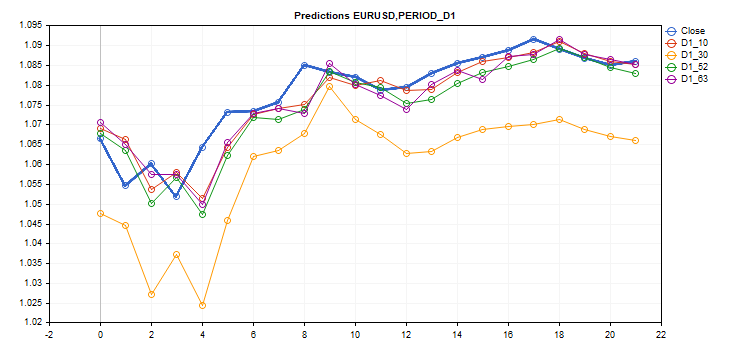
我们看到图表 D1_30 与实际收盘价和其它预测相差甚远。 该模型的衡量度没一个让人振奋。 MAE 展现出 1809 个价位的预测准确! 但请记住,该模型最初是为上一篇文章开发的分类模型,而非回归模型。 这个例子很清楚。
我们分别研究其它模型。
第一个分析候选者是 D1_10
[model] [mae] [mse] [rmse] [r2] [mape] [mspe] [rmsle] [0] "D1_10" 0.00381 0.00003 0.00530 0.77720 0.00356 0.00002 0.00257
我们来看一下这个模型的价格预测图表。
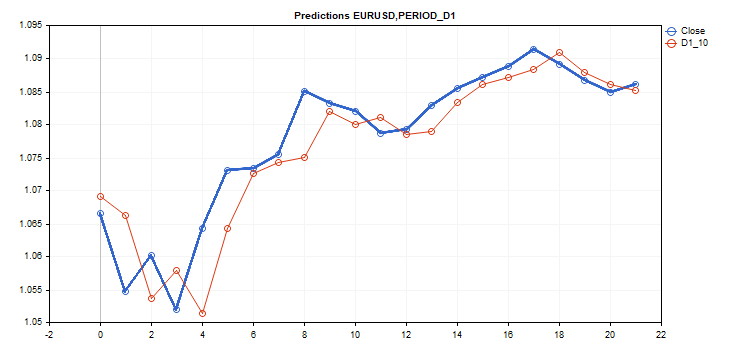
RMSLE 衡量度没有多大意义,因为从 1.05 到 1.09 的扩散远小于一个数量级。 由于 EURUSD 汇率的特殊性,即彼此太接近,故 MAPE 和 MSPE 衡量度的数值接近 MAE 和 MSE。 不过,在计算百分比偏差时会有细微差别,即计算当中没有绝对偏差。
MAPE = |(y_true-y_pred)/y_true| 如果 y_true = 10 且 y_pred = 5 MAPE = 0.5 如果 y_true = 5 且 y_pred = 10 MAPE = 1.0
换言之,这个衡量度(如MSPE)是非对称的。 这意味着,在预测值高于实际的情况下,我们会得到较大的误差。
针对那些纯粹出于方法论目的而拼凑在一起的简单模型,R-平方的衡量度已经达成了优良的结果,即展示如何在 MQL5 中使用 ONNX 模型。
第二候选者 — D1_63
[model] [mae] [mse] [rmse] [r2] [mape] [mspe] [rmsle] [3] "D1_63" 0.00413 0.00003 0.00559 0.75230 0.00385 0.00003 0.00270
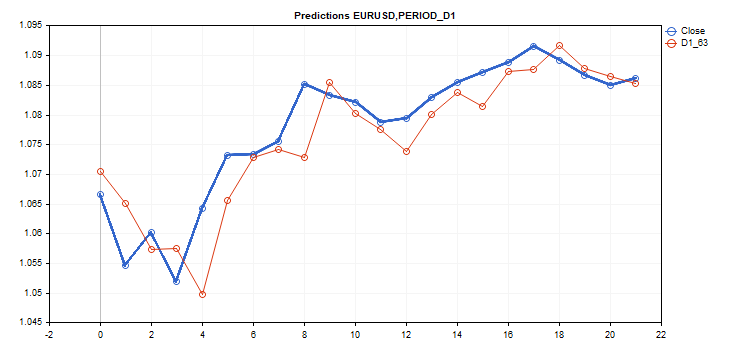
该预测直觉上与前一个预测非常相似。 衡量度数值确认相似性
[0] "D1_10" 0.00381 0.00003 0.00530 0.77720 0.00356 0.00002 0.00257 [3] "D1_63" 0.00413 0.00003 0.00559 0.75230 0.00385 0.00003 0.00270
接下来,我们在测试器中看看这些模型中哪个于同期表现更好。
现在是 D1_52
[model] [mae] [mse] [rmse] [r2] [mape] [mspe] [rmsle] [2] "D1_52" 0.00472 0.00004 0.00642 0.67327 0.00440 0.00004 0.00311
我们研究它只是因为它的 R-平方大于 0.5
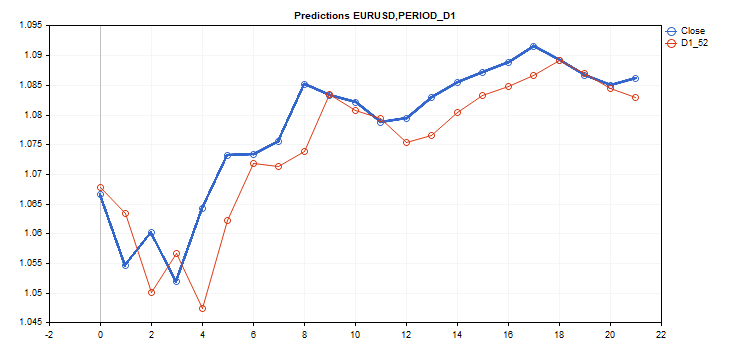
几乎所有预测价格都低于收盘价图表,与我们最坏的情况一样。 即使与前两个模型的衡量度数值相比,该模型并没有激发任何乐观情绪。 我们将在下一段中对此进行检查。
在测试器中运行 ONNX 模型
下面是一个非常简单的 EA,可在测试器中检查我们的模型
//+------------------------------------------------------------------+ //| ONNX.eurusd.D1.Prediction.mq5 | //| Copyright 2023, MetaQuotes Ltd. | //| https://www.mql5.com | //+------------------------------------------------------------------+ #property copyright "Copyright 2023, MetaQuotes Ltd." #property link "https://www.mql5.com" #property version "1.00" #include "ModelEurusdD1_10.mqh" #include "ModelEurusdD1_30.mqh" #include "ModelEurusdD1_52.mqh" #include "ModelEurusdD1_63.mqh" #include <Trade\Trade.mqh> input double InpLots = 1.0; // Lots amount to open position //CModelEurusdD1_10 ExtModel; //CModelEurusdD1_30 ExtModel; CModelEurusdD1_52 ExtModel; //CModelEurusdD1_63 ExtModel; CTrade ExtTrade; //+------------------------------------------------------------------+ //| Expert initialization function | //+------------------------------------------------------------------+ int OnInit() { if(!ExtModel.Init(_Symbol,_Period)) return(INIT_FAILED); Print("model ",ExtModel.GetModelName()); //--- return(INIT_SUCCEEDED); } //+------------------------------------------------------------------+ //| Expert deinitialization function | //+------------------------------------------------------------------+ void OnDeinit(const int reason) { ExtModel.Shutdown(); } //+------------------------------------------------------------------+ //| Expert tick function | //+------------------------------------------------------------------+ void OnTick() { if(!ExtModel.CheckOnTick()) return; //--- predict next price movement vector prob(3); int predicted_class=ExtModel.PredictClass(TimeCurrent(),prob); Print("predicted class ",predicted_class); //--- check trading according to prediction if(predicted_class>=0) if(PositionSelect(_Symbol)) CheckForClose(predicted_class); else CheckForOpen(predicted_class); } //+------------------------------------------------------------------+ //| Check for open position conditions | //+------------------------------------------------------------------+ void CheckForOpen(const int predicted_class) { ENUM_ORDER_TYPE signal=WRONG_VALUE; //--- check signals if(predicted_class==PRICE_DOWN) signal=ORDER_TYPE_SELL; // sell condition else { if(predicted_class==PRICE_UP) signal=ORDER_TYPE_BUY; // buy condition } //--- open position if possible according to signal if(signal!=WRONG_VALUE && TerminalInfoInteger(TERMINAL_TRADE_ALLOWED)) { double price=SymbolInfoDouble(_Symbol,(signal==ORDER_TYPE_SELL) ? SYMBOL_BID : SYMBOL_ASK); ExtTrade.PositionOpen(_Symbol,signal,InpLots,price,0,0); } } //+------------------------------------------------------------------+ //| Check for close position conditions | //+------------------------------------------------------------------+ void CheckForClose(const int predicted_class) { bool bsignal=false; //--- position already selected before long type=PositionGetInteger(POSITION_TYPE); //--- check signals if(type==POSITION_TYPE_BUY && predicted_class==PRICE_DOWN) bsignal=true; if(type==POSITION_TYPE_SELL && predicted_class==PRICE_UP) bsignal=true; //--- close position if possible if(bsignal && TerminalInfoInteger(TERMINAL_TRADE_ALLOWED)) { ExtTrade.PositionClose(_Symbol,3); //--- open opposite CheckForOpen(predicted_class); } } //+------------------------------------------------------------------+
其实,根据 D1_52 模型,只开立了一笔卖出交易,并且根据该模型,在整个测试期间趋势都未变化。
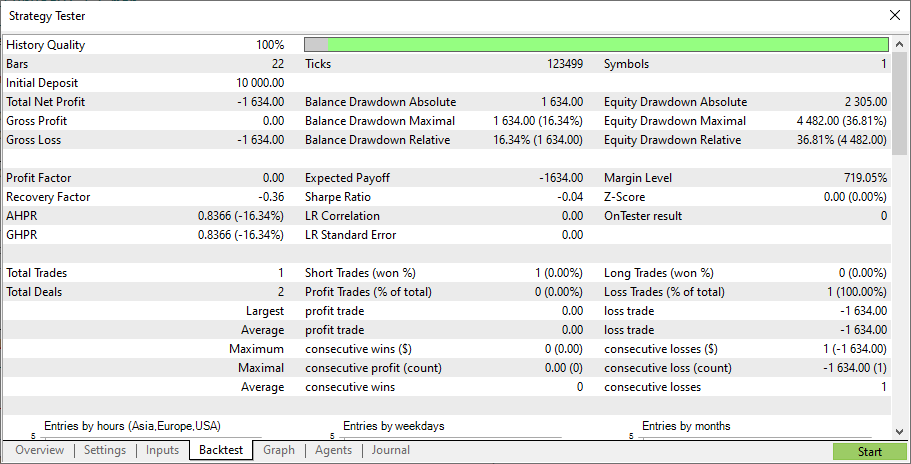
2023.06.09 16:18:31.967 Symbols EURUSD: symbol to be synchronized 2023.06.09 16:18:31.968 Symbols EURUSD: symbol synchronized, 3720 bytes of symbol info received 2023.06.09 16:18:32.023 History EURUSD: load 27 bytes of history data to synchronize in 0:00:00.001 2023.06.09 16:18:32.023 History EURUSD: history synchronized from 2011.01.03 to 2023.04.07 2023.06.09 16:18:32.124 History EURUSD,Daily: history cache allocated for 283 bars and contains 260 bars from 2022.01.03 00:00 to 2022.12.30 00:00 2023.06.09 16:18:32.124 History EURUSD,Daily: history begins from 2022.01.03 00:00 2023.06.09 16:18:32.126 Tester EURUSD,Daily (MetaQuotes-Demo): 1 minutes OHLC ticks generating 2023.06.09 16:18:32.126 Tester EURUSD,Daily: testing of Experts\article_2\ONNX.eurusd.D1.Prediction.ex5 from 2023.01.01 00:00 to 2023.02.01 00:00 started with inputs: 2023.06.09 16:18:32.126 Tester InpLots=1.0 2023.06.09 16:18:32.161 ONNX api version 1.16.0 initialized 2023.06.09 16:18:32.180 ONNX.eurusd.D1.Prediction (EURUSD,D1) 2023.01.01 00:00:00 model D1_52 2023.06.09 16:18:32.194 ONNX.eurusd.D1.Prediction (EURUSD,D1) 2023.01.02 07:02:00 predicted class 2 2023.06.09 16:18:32.194 Trade 2023.01.02 07:02:00 instant sell 1 EURUSD at 1.07016 (1.07016 / 1.07023 / 1.07016) 2023.06.09 16:18:32.194 Trades 2023.01.02 07:02:00 deal #2 sell 1 EURUSD at 1.07016 done (based on order #2) 2023.06.09 16:18:32.194 Trade 2023.01.02 07:02:00 deal performed [#2 sell 1 EURUSD at 1.07016] 2023.06.09 16:18:32.194 Trade 2023.01.02 07:02:00 order performed sell 1 at 1.07016 [#2 sell 1 EURUSD at 1.07016] 2023.06.09 16:18:32.195 ONNX.eurusd.D1.Prediction (EURUSD,D1) 2023.01.02 07:02:00 CTrade::OrderSend: instant sell 1.00 EURUSD at 1.07016 [done at 1.07016] 2023.06.09 16:18:32.196 ONNX.eurusd.D1.Prediction (EURUSD,D1) 2023.01.03 00:00:00 predicted class 2 2023.06.09 16:18:32.199 ONNX.eurusd.D1.Prediction (EURUSD,D1) 2023.01.04 00:00:00 predicted class 2 2023.06.09 16:18:32.201 ONNX.eurusd.D1.Prediction (EURUSD,D1) 2023.01.05 00:00:30 predicted class 2 2023.06.09 16:18:32.203 ONNX.eurusd.D1.Prediction (EURUSD,D1) 2023.01.06 00:00:00 predicted class 2 2023.06.09 16:18:32.206 ONNX.eurusd.D1.Prediction (EURUSD,D1) 2023.01.09 00:02:00 predicted class 2 2023.06.09 16:18:32.208 ONNX.eurusd.D1.Prediction (EURUSD,D1) 2023.01.10 00:00:00 predicted class 2 2023.06.09 16:18:32.210 ONNX.eurusd.D1.Prediction (EURUSD,D1) 2023.01.11 00:00:00 predicted class 2 2023.06.09 16:18:32.213 ONNX.eurusd.D1.Prediction (EURUSD,D1) 2023.01.12 00:00:00 predicted class 2 2023.06.09 16:18:32.215 ONNX.eurusd.D1.Prediction (EURUSD,D1) 2023.01.13 00:00:00 predicted class 2 2023.06.09 16:18:32.217 ONNX.eurusd.D1.Prediction (EURUSD,D1) 2023.01.16 00:03:00 predicted class 2 2023.06.09 16:18:32.220 ONNX.eurusd.D1.Prediction (EURUSD,D1) 2023.01.17 00:00:00 predicted class 2 2023.06.09 16:18:32.222 ONNX.eurusd.D1.Prediction (EURUSD,D1) 2023.01.18 00:00:30 predicted class 2 2023.06.09 16:18:32.224 ONNX.eurusd.D1.Prediction (EURUSD,D1) 2023.01.19 00:00:00 predicted class 2 2023.06.09 16:18:32.227 ONNX.eurusd.D1.Prediction (EURUSD,D1) 2023.01.20 00:00:30 predicted class 2 2023.06.09 16:18:32.229 ONNX.eurusd.D1.Prediction (EURUSD,D1) 2023.01.23 00:02:00 predicted class 2 2023.06.09 16:18:32.231 ONNX.eurusd.D1.Prediction (EURUSD,D1) 2023.01.24 00:00:00 predicted class 2 2023.06.09 16:18:32.234 ONNX.eurusd.D1.Prediction (EURUSD,D1) 2023.01.25 00:00:00 predicted class 2 2023.06.09 16:18:32.236 ONNX.eurusd.D1.Prediction (EURUSD,D1) 2023.01.26 00:00:00 predicted class 2 2023.06.09 16:18:32.238 ONNX.eurusd.D1.Prediction (EURUSD,D1) 2023.01.27 00:00:00 predicted class 2 2023.06.09 16:18:32.241 ONNX.eurusd.D1.Prediction (EURUSD,D1) 2023.01.30 00:03:00 predicted class 2 2023.06.09 16:18:32.243 ONNX.eurusd.D1.Prediction (EURUSD,D1) 2023.01.31 00:00:00 predicted class 2 2023.06.09 16:18:32.245 Trade 2023.01.31 23:59:59 position closed due end of test at 1.08621 [#2 sell 1 EURUSD 1.07016] 2023.06.09 16:18:32.245 Trades 2023.01.31 23:59:59 deal #3 buy 1 EURUSD at 1.08621 done (based on order #3) 2023.06.09 16:18:32.245 Trade 2023.01.31 23:59:59 deal performed [#3 buy 1 EURUSD at 1.08621] 2023.06.09 16:18:32.245 Trade 2023.01.31 23:59:59 order performed buy 1 at 1.08621 [#3 buy 1 EURUSD at 1.08621] 2023.06.09 16:18:32.245 Tester final balance 8366.00 USD 2023.06.09 16:18:32.249 Tester EURUSD,Daily: 123499 ticks, 22 bars generated. Environment synchronized in 0:00:00.043. Test passed in 0:00:00.294 (including ticks preprocessing 0:00:00.016).
如上一章节所述,D1_52 模型并不能激发乐观情绪。 测试结果证实了这一点。
我们只修改两行代码
#include "ModelEurusdD1_10.mqh" #include "ModelEurusdD1_30.mqh" #include "ModelEurusdD1_52.mqh" #include "ModelEurusdD1_63.mqh" #include <Trade\Trade.mqh> input double InpLots = 1.0; // Lots amount to open position CModelEurusdD1_10 ExtModel; //CModelEurusdD1_30 ExtModel; //CModelEurusdD1_52 ExtModel; //CModelEurusdD1_63 ExtModel; CTrade ExtTrade;
并启动模型 D1_10 进行测试。

结果很好。 测试图形也很有前途。
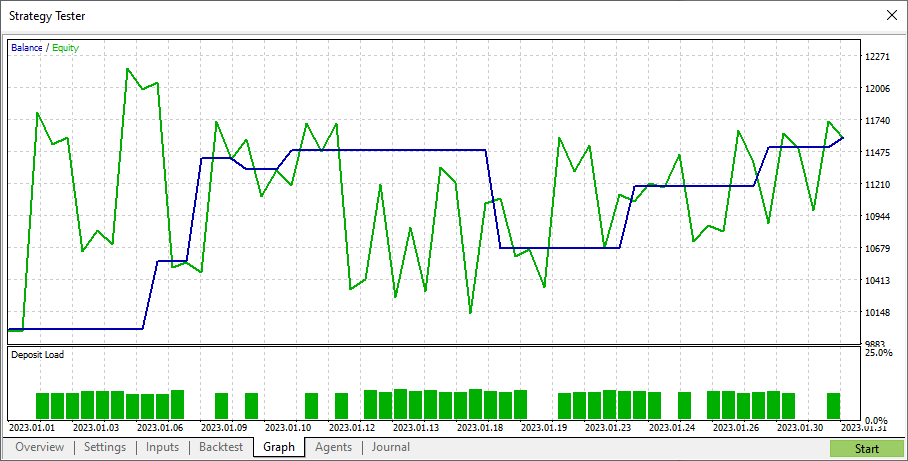
我们再次修复两行代码,并测试 D1_63 模型。
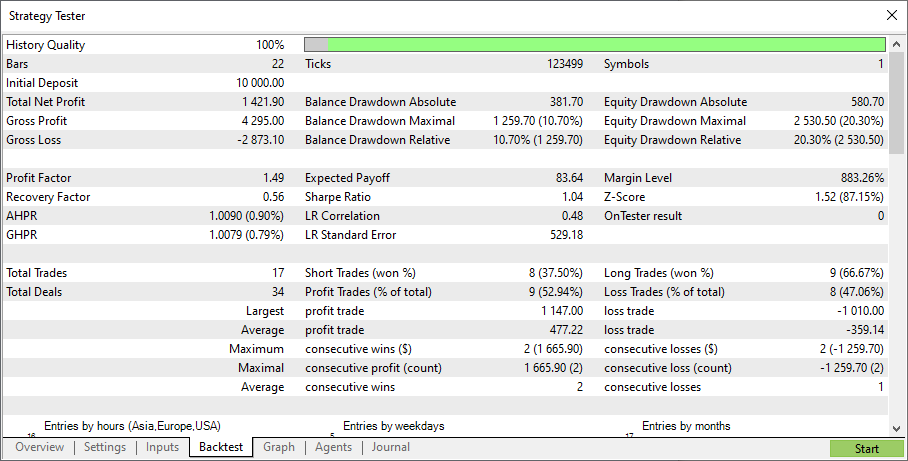
图形
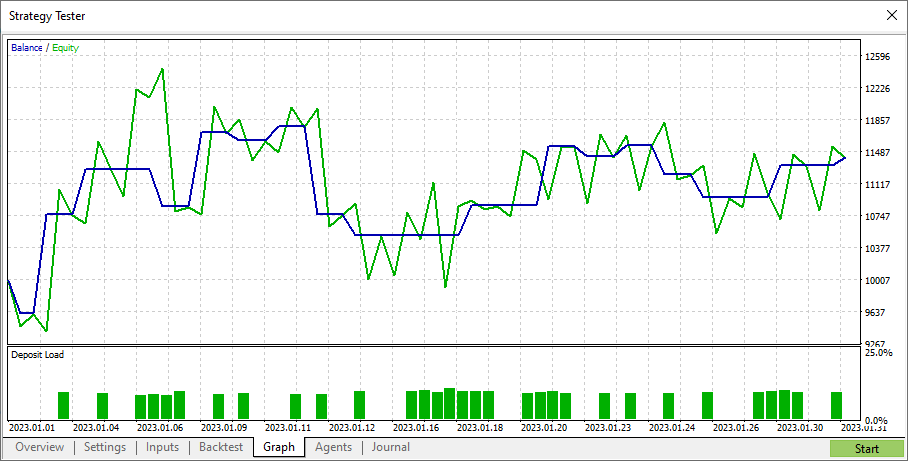
测试图形比 D1_10 模型差很多。
比较两个模型 D1_10 和 D1_63,我们可以看出第一个模型比第二个具有更好的回归衡量度。 测试器显示相同的内容。
重要提示:请听忠告,本文所用模型仅出于演示如何利用 MQL5 语言处理 ONNX 模型。 智能交易系统并不适用于实盘账户交易。
结束语
评估价格预测模型的最适宜衡量度是 R-平方。 研究 MAE—RMSE—MAPE 的聚合可能非常实用。 在价格预测任务中也许无需考虑 RMSLE 衡量度。 它对于拥有若干个模型的评估非常实用,即便它是经过修改的同一模型。
我们都明白 22 个样本值尚不足以进行严谨的研究,但我们无意进行统计研究。 我们只提供替代用例。
本文由MetaQuotes Ltd译自俄文
原文地址: https://www.mql5.com/ru/articles/12772
注意: MetaQuotes Ltd.将保留所有关于这些材料的权利。全部或部分复制或者转载这些材料将被禁止。